Abstract
Urban growth is one of the major causes of flooding in urban areas. This affects the runoff coefficients, which is among the most important factors that affect the design of storm water drainage systems. Changing the runoff coefficient will affect the design parameters of the drainage network, including outfall discharge, velocity, lag time and cost of construction. This study aims to assess the effect of changing the runoff coefficient due to urban growth on the design of a storm water drainage system. The hydrological models Hyfran, StormCAD and GIS are used to analyze different runoff coefficients. This study examines three zones in Dammam in the Kingdom of Saudi Arabia (KSA). The data developed from the models for the current case studies are used to develop an empirical equation to predict the max discharge for other catchments. The discharge is a function of the return period, runoff coefficient, drainage density, longest path, rainfall intensity and catchment area. To validate the developed equation, we use it to estimate the discharge in a real case study in South Korea. A comparison between the measured discharge and estimated discharge shows that the empirical equation is capable of predicting the maximum discharge for different catchments with high accuracy. Then, the validation of the models is carried out to determine the effect of the runoff coefficient on the design of a storm water drainage system in a case study in KSA. The results show that an increasing runoff coefficient due to urban growth increases the outfall discharge and velocity of storm water drainage systems, as well as affecting the cost of construction and decreasing the lag time. The cost increases by two to three times with increasing urbanization. This study provides a new perspective on the hydrologic impact of urban growth on the design of storm water drainage systems, which are essential for flood management. Moreover, the relationship between urban growth and the cost of storm drainage networks is explored, which could help decision makers to make appropriate judgements.
1. Introduction
Urban growth tends to create an impervious ground surface, which increases the possibility of flooding in urban areas due to the construction of roads and buildings. Impermeable areas lead to the accumulation of storm water on the ground surface which in turn affects the infrastructure and transportation. To reduce such effects, an appropriate storm network is required. The runoff coefficient is one of the main factors affecting the design of storm water drainage systems. Changing the runoff coefficient could affect the design parameters of the drainage network, including outfall discharge, velocity, lag time and cost of construction. Storm water network management is one of the most important aspects of developed cities due to changes in land surface permeability and the percolation of water. Zeleňáková et al. (2019) [1] studied the percolation of water from surface runoff with an emphasis on the retention capacity of the selected territory and the intensity of precipitation. The results proved that a geological study must always be conducted with any decision on rainwater percolation in a certain locality. Its range is dependent on the difficulty and type of construction.
Recent technological tools such as StormCAD, CivilCAD, SewerGEMS and the Storm Water Management Model (SWMM) can be used in the management of storm water. These tools are accurate and less time consuming for the design of the drainage network. StormCAD software is commonly used for designing storm water drainage systems in numerous areas of the world. Bentley [2] gave a brief introduction to StormCAD and its features. StormCAD can be used to determine the actual catchment runoff, gutters, inlets, junctions and pipe networks. It is also used to determine the pipe diameters, slopes, invert elevations, depths of flow, velocity and hydraulic grade lines.
Storm water drainage system management was studied in different areas using different hydrological models. Gould et al. [3] used StormCAD in Fairbanks (Alaska) to observe the correlation between different types of heavy metals found in storm water. Bentley [4] provided six suitably sized infiltration basins without affecting a racetrack in New Jersey, using different types of storm water models such as StormCAD, Pond pack, HEC-RAS and Flow Master. Pazwash [5] presented an overview of design parameters for the management of urban storm water systems in New Jersey. Villarreal et al. [6] analyzed the functions of a drainage system by SWMM in Östra Torn, Lund, Sweden. They proposed, instead of connecting two storm water systems, the provision of retention storage, which is much appropriate. Jia et al. (2019) [7] developed an integrated city drainage model that configures typical urban forms and their associated drainage infrastructures, specifically domestic wastewater and rainwater systems, to analyze the relationship between them. They used the Storm Water Management Model (SWMM) in the study. The results showed that urban forms play more important roles in the performance, economic efficiency, effectiveness, and adaptability of the rainwater systems than wastewater systems. Zhang et al. (2019) [8] linked the hydrological and bioecological benefits of green infrastructures on different spatial scales. The results showed additional challenges in the planning of these measures.
Urbanization is one of the major driving forces that worsens the performance of drainage systems. Huang et al. [9] studied the effect of growing watershed imperviousness on hydrograph parameters and peak discharge. Various flood-routing techniques were used. The study presented a design chart for the peak flow relation to support engineers to erect hydraulic structures efficiently and avoid probable harm to human life and property. Du et al. [10] studied the relationship between urbanization and annual runoff in Qinhuai River watershed in Jiangsu Province, China. They used the HEC-HMS model. The results indicated that runoff discharge and volume have enlarged to different degrees due to urban extension. Hundecha and Bardossy [11] used lumped hydrology models to study the relation between runoff discharges and urban growth. The study was done on 95 watershed areas in the Rhine basin. The results indicated that increased urbanization leads to an increased peak in summer and winter storms, an effect that was significantly noticeable in the summer. Yanga et al. [12] studied the effect of urban growth in central India on runoff discharge in a small catchment and a large river using GIS. Seven scenarios were established with equal urban areas distributed in different isochrone zones. The results indicated that peak discharge tends to be smaller and arrive faster with urbanization if development occurs in areas with smaller travel times.
A number of recent studies focus on the effect of urban growth on the runoff and redesign of drainage systems. Kumar et al. [13] used 20 years of rainfall data in the redesign of a storm water drainage system for Vijayawada City in Andhra Pradesh, India. The rational method was used for the estimation of storm water runoff in order to design the drainage system and assess the current drainage system. It was noticed that current sections are not sufficient in most of the places to accommodate the runoff due to blockages in the drains at various points, which require periodical maintenance of existing drains. Kumar et al. [14] presented a comprehensive study to assess the storm sewer systems in urban areas in the northern part of Vellore town. Three alternatives were proposed in this study. They used a new system (first alternative), the repair and expansion of the existing system (second alternative) and the construction of swales (third alternative). The results showed that alternative 2 is cheaper; however, it can be claimed that, due to their efficiency, 1 and 3 are favorable alternatives.
A number of researchers studied the adaptability of fixed drainage systems to various future conditions due to urban growth and climate change [15,16]. Semadeni-Davies et al. [17] assessed the effect of urban growth and climate change on storm water discharges in Helsingborg, southern Sweden. The results showed that urban growth with heavy rainfall could lead to an increased flow and volume of runoff that may increase the possibility of flooding. Jacobs and Srinivasan [18] presented a study to estimate more accurate runoff values for water resources planning and management. They compared the results of the modified Natural Resources Conservation Service (NRCS) curve number equation with radar rainfall data to estimate runoff. The study showed a convergence between estimated data and observed data in the curve number of dry antecedent soil moisture condition and a reduced initial abstraction coefficient.
Urbanization worsens the performance of drainage systems. The characteristics of urban form change include constructed areas and impervious surfaces, which lead to increased flooding volumes [19]. In addition to increased impervious surfaces, other characteristics such as geometry and roof area can be conceptualized by software that performs the refined simulation and management of urban water systems [20]. With an urban development model that relies on minimal data, the population distribution and building attributes could be simulated and easily interlinked with urban water models; the application of this technology to the city of Innsbruck shows that an analysis of numerous spatial scenarios is accessible and necessary, which enables proactive adaptation of the option to prioritize the development of some areas, which, in turn, places less stress on the existing network [21].
Arid and semi-arid regions are exposed to different flood events. These regions are suffering from a lack of proper storm water drainage systems. The Kingdom of Saudi Arabia (KSA) is among the large countries exposed to different flood events annually [22]. The resultant risks can be controlled using suitable and precise flood prediction. GIS and remote sensing can help in flood prediction and modelling [23] in addition to probabilistic-based methods [24]. A number of studies have been developed to protect different regions in KSA from flood in Makkah by Dawod et al. [25] and in Jeddah by Abosuliman et al. [26] and Youssef et al. [27].
Li et al. (2015) [28] investigated ideal detention tank design under the local flooding constraints of regulatory standards, with the aim of improving an already effective and strong method and outlining a new detention tank design system. An adapted particle swarm optimizer was used with hydraulic simulation (SWMM) to find non-dominated solutions to diminish both flooding risks and the engineering costs. The results confirmed the validity and feasibility of the suggested methodological outline for multi-objective ideal detention tank design in urban storm water drainage systems (USDS). Ting Su et al. (2018) [29] developed a multi-objective optimization (MOO) design outline to define the best safeguard level for a levee system based on different flexibility pointers that depend on the probabilistic features of the flood destruction costs rising due to the uncertain nature of precipitation. An algorithm was used to find a set of non-dominated solutions, known as Pareto best solutions, for the optimal defense level. The results indicate that the suggested outline aids the application of MOO with elasticity objectives for a flood protection system design operating under uncertainty and solves the decision-making problems efficiently by radically reducing the required computational time. Duan et al. (2016) [30] explored and extended further an ideal methodological design outline for an urban storm water drainage system (USDS) with uncertainties in China. An uncertainty investigation was initially conducted to describe the importance of different uncertainty features considered in the studied system. The results of the study were deliberated in the paper in relation their practical implications for the design and management of USDSs. Li et al. (2019) [31] studied the management of water quality and control of urban flooding with the application of a detention tank (DT) and low-impact development (LID) in USDSs. A multi-objective optimization (MOO)-based outline design and analysis method was established to obtain four objectives for USDS design. The results and analysis proved the efficiency and applicability of the designed DTs and LIDs to alleviate flooding hazards and improve water quality in USDSs. Mohammadiun et al. (2018) [32] developed a new flexible and stochastic method by linking many objective optimization algorithms to a numerical solver/meta-model within a Copula-based Monte Carlo outline in order to design/rehabilitate USDSs, considering the related probabilities of internal and external unforeseen conditions of loading. The results indicated the significance of considering flexibility in the rehabilitation of the Tehran Stormwater Drainage System (TSDS), Tehran, Iran. Ideal plans, including a set of bypass lines, release tunnels, and storage elements, exhibited acceptable performance in terms of improving the network’s flexibility.
This study aims to evaluate the impact of changing the runoff coefficient due to urban growth on the design of storm water drainage systems. StormCAD is used to assess the impact of different runoff coefficients (C) on the outfall discharge and velocity in the pipe network. Moreover, the lag time is calculated for different scenarios, in addition to the cost of the pipe network for different return periods. GIS is used to present the results of the considered scenarios. The study is applied to three zones in Dammam, KSA. Urban growth includes additional roads, parking and residential areas that lead to increases in the outflow of the storm drainage network. This increases the cost of infrastructure, including storm drainage pipe systems. The main aim of this study is to find a relationship between urban growth and the cost of storm drainage networks. This could help the decision makers and designers in taking appropriate decisions based on the developed relationship between urban growth and the cost of storm drainage networks.
2. Materials and Methods
In this study, a number of watershed management models were applied to different case studies to highlight the effect of using the available DEMs from different sites on watershed geomorphological properties and delineation.
The methodology of the current study includes data collection and the use of hydrological models for the simulation of runoff. The collected data include hydrological data, topographic maps, digital elevation models, land use, Google Earth satellite images and Landsat images. The Hyfran model is used for rainfall data statistical analysis, StormCAD is used for the design of the storm water drainage system for different return periods and different runoff coefficients. These are used to analyze the storm sewer system from the gutter to the outlet. StormCAD estimates the actual overflow of catchment, stub out, manholes, pipe diameters, and outlets [33]. The inputs of the program include ground level, manhole spacing, rainfall intensity and runoff coefficient. The design procedure is controlled by constraints such as pipe diameters and materials, minimum and maximum velocity, covers, slopes and pipe connections. The outputs of the program are the pipe diameters, pipe invert levels, depth of flow and velocity. GIS is used to present the results.
The rational method is used to calculate the peak discharge of the storm network system and the equation can be written as follows:
where Q is the peak discharge at outlet of the storm network system (m3/s), C is the runoff coefficient, which depends mainly on the type of surface (dimensionless), I is the intensity of rainfall (mm/h), A is the cumulative area downstream the design section (hectare).
Q = C × I × A/360
The calculation of rainfall intensity at the outfall point requires the calculation of the time of concentration. The time of concentration represents the time of flow from a faraway point in catchment area to the point of design. The time of concentration is divided into two parts: time of entry and time of travel. Time of entry is defined as the time taken by water drops to arrive on the ground surface and enter the gutter. The Kirpich equation is used to compute the time of entry, as shown in Equation (2); however, the minimum time of entry is taken to be 10 min [34]. The travel time is defined as the time taken to convey rainwater through the storm network’s pipes, which depends on flow velocity, the travel distance (storm pipe length), the pipe slope, sewer diameters, sewer flow discharge, and sewer material. The following equation has been used to determine the time of entry:
where T is the time of entry (min), L is the travel length for water in catchment area (m), S is the catchment area slope (m/m).
T = 0.0195 × L0.77 × S−0.385
The above equation is valid for slopes (3% to 10%); for concrete or asphalt surfaces, multiply T by 0.4; for concrete canals, multiply it by 0.2 [35].
Manning’s equation is used by the StormCAD program to design the pipe diameter; this equation is defined below as:
where:
Q = (1/n) × A × R2/3 × S1/2
- Q is the peak discharge through the pipe (m3/s);
- A is the cross-section area of the pipe (m2);
- n is the Manning’s roughness coefficient (n = 0.010);
- R is the hydraulic radius (R = A/P) (m);
- S is the pipe slope (m/m).
3. Study Area
Saudi Arabia is constructing new urban communities to relieve pressure on major cities, improve living conditions for citizens and improve infrastructure. The study area is located near Dammam in the Kingdom of Saudi Arabia (KSA), which is located 17 km from the Arabian Gulf and 7 km from Dammam city. Figure 1 shows the location map of the study area. It is divided into a number of zones. In this study, three zones are considered, A, C and E, as shown in Figure 1. Three zones are selected due to the variation in KSA’s official master plan, outlets and urbanization ratio to study the effect of urban growth and return period design on different parameters such as outlet discharge, velocity in storm drainage pipes and the time of arrival of water from the furthest point in the region to the outlet (time of concentration), as well as the cost of construction for the storm water drainage network.
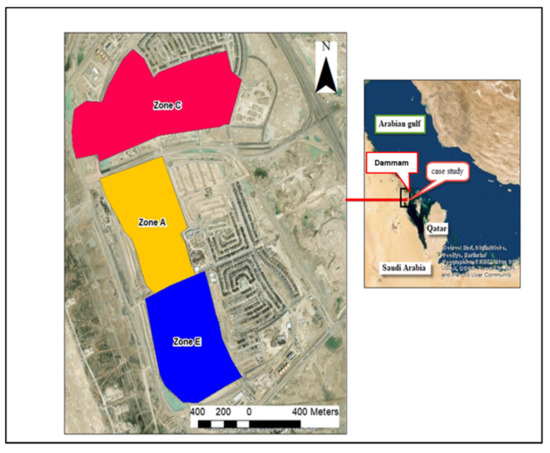
Figure 1.
Location map of the study area.
3.1. Topographic Data
Three zones were considered in this study, A, C and E, which have different characteristics. The first zone (A) is located at 26°15′35.10″ N, 50°4′0.32″ E, the second zone (C) is located at 26°16′5.02″ N, 50°4′10.12″ E, and the third zone (E) is located at 26°15′4.43″ N, 50°4′9.37″ E. The area of the first zone (A) is equal to 0.4 km2. This zone is located in the central part of the study area. It is bordered by zone (C) from the north and zone (E) from the south, as shown in Figure 1. The ground surface elevation of this zone ranges from 4.1 to 12.8 m, as shown in Figure 2a. The ground slope extended from east to west and from east to south. According to these conditions, the layout of the storm water drainage network of this zone is lined up with these coordinates, as shown in Figure 3a. There are seven existing disposal points that drain their water to a concrete culvert with dimensions of 2.00 × 1.00 m around the study area, so all pipes are distributed to these points; the total length of the storm pipes is 3 km.
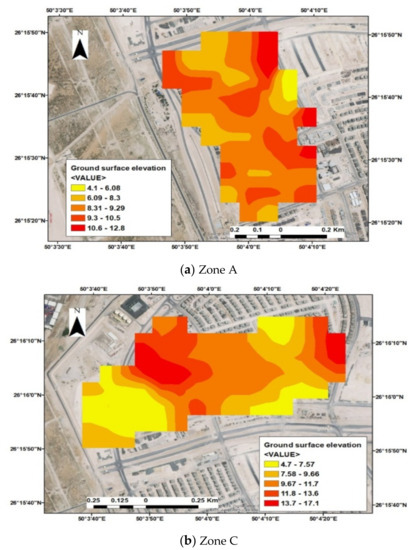
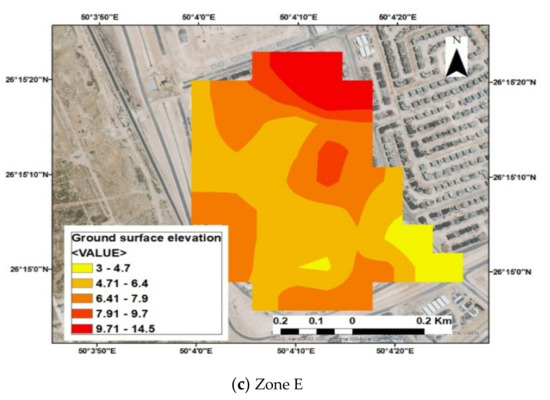
Figure 2.
Ground surface elevation of zones A (a), C (b) and E (c).
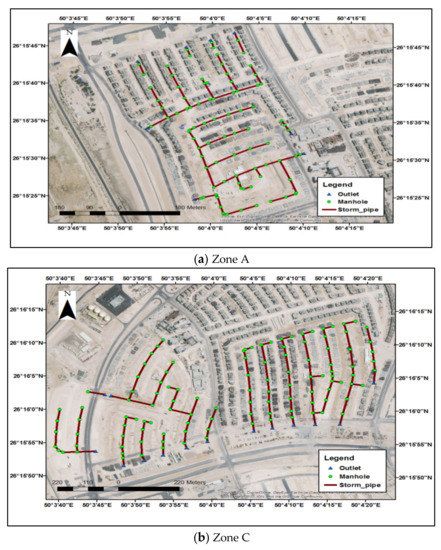
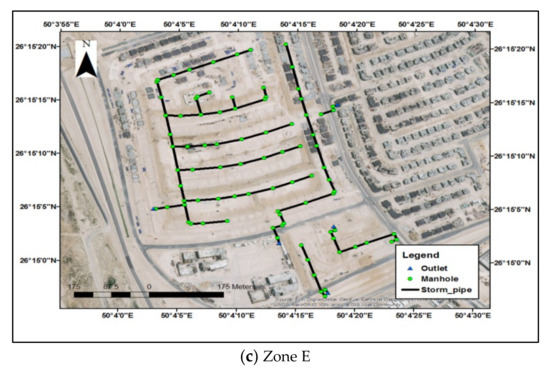
Figure 3.
Storm water drainage system layout of zones A (a), C (b) and E (c).
The second zone (C)’s area is equal to 0.7 km2. This zone is located in the north of the study area, as is shown in Figure 1. The elevation of this zone ranges from 4.3 to 17.2 m above mean sea level, as shown in Figure 2b. The ground slope extended from east to west and from east to south; according to this condition, the layout of the storm water drainage network of this zone is lined up with these directions as shown in Figure 3b. There are 14 exit disposal points so all pipes area distributed to these points and the total length of storm pipes is 4 km. The third zone (E) area is equal to 0.5 km2. This zone is located at the south of the studied areas as shown in Figure 1. The elevation of this zone ranged from 3 to 14.50 m as is shown in Figure 2c. The ground slope extended from north to south; according to these conditions, the layout of the storm water drainage network of this zone is lined up with these coordinates, as shown in Figure 3c. There are five exit disposal points, so all pipes are distributed to these points; the total length of the storm pipes is 3.50 km.
3.2. Meteorological Data
The daily rainfall data for 30 years from Dammam rain gauge station were collected to estimate runoff. The total rainfall values received in the given period at the Dammam station are highly variable from one year to another. This variability depends on the climate conditions and the length of the considered period. It can be stated that Dammam has a dry climate and shows a high variability in rainfall over time. Quality control programs were used for spatial and time series rainfall data from Dammam and relationships between elements. In addition to these programs, standard deviations and variation coefficients were calculated and compared with other model results such as Hyfran (Hydrological Frequency Analysis) software, which is used to fit statistical distributions through mathematical tools for the statistical analysis of extreme events. Bell’s equation (1969) [36] was used to calculate the short duration rainfall intensity from daily rainfall intensity. The results are shown in Figure 4; the maximum rainfall intensity at different return periods could be estimated for use in predicting the flood frequency analysis of Dammam station. Figure 4 shows the Intensity Duration Frequency Curve (IDF) of the Dammam rainfall station [36].
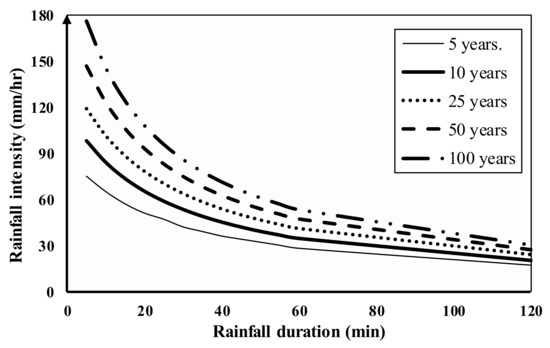
Figure 4.
IDF curve for the study area (Dammam rainfall station).
4. Results and Discussion
In this study, the layout of the storm water drainage system was prepared, then the outfall discharges, velocities and lag times were estimated using StormCAD for the base case in a 5-year return period and a runoff coefficient of 0.20. Figure 5 shows a flow chart of the StormCAD simulation process, which explains the steps of using StormCAD in a simulation. The cost of the system is also estimated for each zone. Samples of the results for the base case are listed in Table 1 for zones A, C and E. The results show that zone C gave the largest discharge, largest cost and the smallest lag time because it has the largest area and the shortest path line to the planned outlet, as shown in Table 1. The cost of the storm water drainage system was calculated based on the market prices in KSA. Table 2 shows the cost of the supply and installation of different pipe diameters according to the current market prices. The total cost of the storm water drainage system is calculated based on the cost of the pipes, which represent 40% of the total cost.
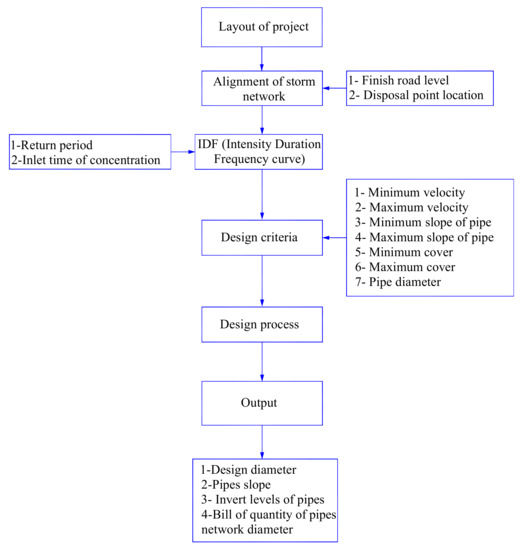
Figure 5.
Flow chart of StormCAD simulation process.

Table 1.
The calculated values of base case for zones A, C and E.

Table 2.
Cost of supply and installation of different pipe diameters [37].
StormCAD is used to assess different runoff coefficients (0.2, 0.4, 0.6, 0.8 and 1) for different return periods (5, 10, 25, 50 and 100).
4.1. Relationship between Runoff Coefficient and Outlet Discharges
In this scenario, the effect of changing the runoff coefficient (C) due to urban growth on the outlet discharge (Q) is calculated for different return periods. The relationship between the runoff coefficient (C) and the ratio of the outlet discharge to the outlet discharge of the base case (Q/Q0) is calculated and presented in Figure 6a–c for the three zones, A, C and E, respectively. The results show that increasing the runoff coefficient increased the outfall discharge for the different return periods.
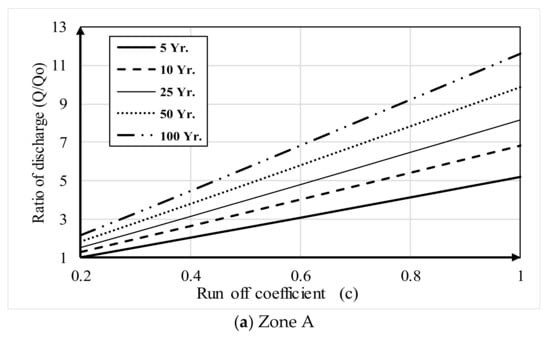
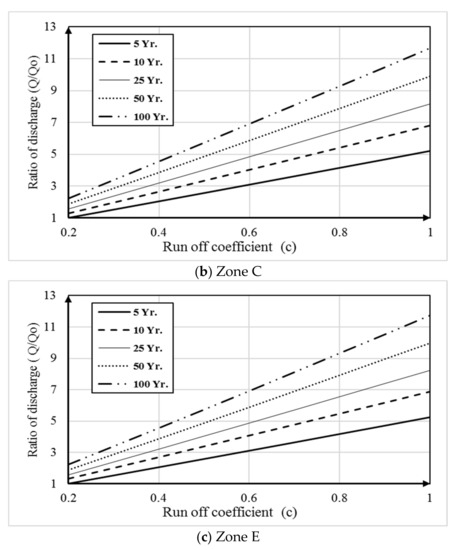
Figure 6.
Relationship between runoff coefficient (C) and outlet discharges of zones A (a), C (b) and E (c).
Increasing the runoff coefficient from 0.20 to 0.60 for return periods 5, 10, 25, 50 and 100 has increased the outfall discharge by three, 4.5, five, six and seven times that of the base case, respectively. However, increasing the runoff coefficient from 0.20 to 0.80 for return periods 5, 10, 25, 50 and 100 has increased the outfall discharge by four, 5.5, 6.25, eight and nine times that of the base case, respectively, as shown in Figure 6. In the worst-case scenario, the runoff coefficient increased from 0.2 to one and the return period changed from five to 100. In this case, the outfall discharge increase by 12 times that of the base case, as shown in Figure 6. This reveals that increasing the runoff coefficient due to urban growth has a clear effect on the outfall discharge.
The empirical equations of max discharge have been deduced according to physical data from studied zones, as listed in Table 3.

Table 3.
Physical data and discharges of studied zones.
A regression analysis was used to estimate the maximum watershed discharge by correlating it with other variables. Equation (4) is developed for watershed discharge as a function of the return period, runoff coefficient, drainage density, longest path, rainfall intensity and catchment area.
where:
- Q is the maximum flow discharge (m3/s);
- Rp is the return period (year);
- C is the runoff coefficient;
- Dd is the drainage density (Km/Km2) (the total length of pipes network to catchment area);
- Lp is the longest path (m) (the maximum distance between remote point to outfall point);
- I is the intensity of rainfall (mm/h);
- A is the area of catchment (Km2);
In this equation, the coefficient of correlation (R2) is 0.90 with a standard error equal to 0.05.
Validation Catchments
For the validation of the developed equation, a case study is selected from South Korea. Five urban catchments in Seoul and Busan, South Korea, were selected, as shown in Figure 7. The physical data and maximum discharges of these zones are listed in Table 4. Descriptions of these zones are as follows:
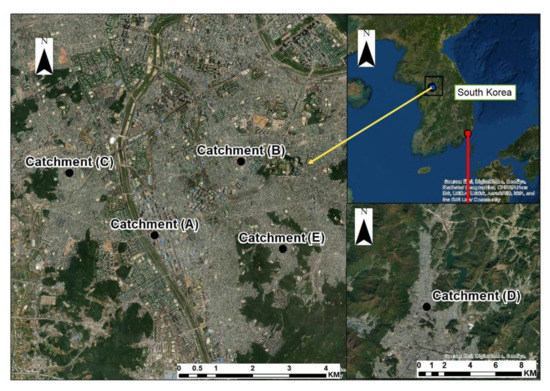
Figure 7.
Site location of validation catchments.

Table 4.
Data of validation catchments [39].
- Catchment A, located in Gasan-dong, Geumcheon-gu, Seoul, was considered for the design of a storm water drainage system for a 30-year flood occurrence period. It has a reservoir volume of 9000 m3. Land description: 73% is covered by industrial areas.
- Catchment B, located in Daelim 3-dong, Yeongdeungpo-gu, Seoul, was also was considered for the design of a storm water drainage system for a 30-year flood occurrence period and has a reservoir volume of 36,200 m3. Land description: residential areas (60%), commercial and business districts (15%), and a highly dense residential area (9%).
- Catchment C is located in Guro, Seoul. Two storm water pump stations are erected in Gaebong 1 and 2, with a reservoir capacity of 156,000 m3 and 3460 m3, respectively. Land description: 19% forest and 39% impervious areas.
- Catchment D is located in the downtown Busan metropolitan area. Since the water level of a nearby river is commonly higher than the city ground, the natural discharge of rainwater to the river is difficult due to the backflow of sewer pipes. Land description: 85% is covered by industrial and residential areas and 15% is covered by forest.
- Catchment E of the Dorimcheon Stream is located in Sinrim-dong, Gwanak-gu, Seoul. There are two pumping stations with reservoir capacities of 8400 and 5300 m3. Land description: 70% is covered by industrial and residential areas and 30% is covered by forest (Lee J. et al., 2018) [38].
The empirical equation was applied to the catchments for validation and the results are listed in Table 4. Moreover, the percentage of error was estimated to be about 16.50% in this equation. In addition, Figure 8 shows a comparison between the calculated discharge using an empirical equation and the estimated discharge. From the results, it can be observed that there is a good agreement between the values; therefore, the equation could be used accurately to predict the max discharge for other catchment area, but a validation process should be done. From this equation, the maximum discharge can be estimated for any catchment area prior to any alignment or design details, which could help and save time for designers.
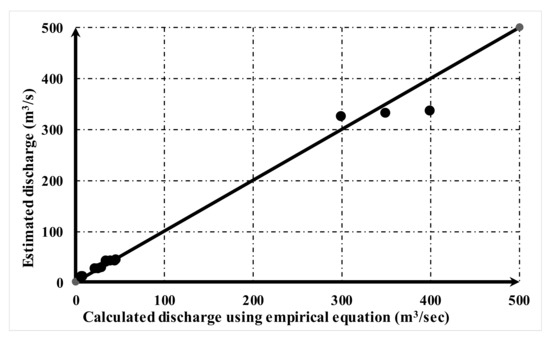
Figure 8.
Comparison between calculated discharge using empirical equation and estimated discharge.
4.2. Relationship between Runoff Coefficient and Cost of the System
The effect of changing the runoff coefficient (C) on the cost of a storm water drainage system is presented in this scenario. Increasing the runoff coefficient (C) has increased the outfall discharge (Q), which increased the pipe diameters and corresponding costs of the system. StormCAD is used to assess the new runoff coefficients. The new outfall discharges and required pipe diameters are calculated according to Manning’s equation; consequently, the cost of the system is calculated. The relationship between the runoff coefficient (C) and the ratio of the current cost to the base case is calculated and presented in Figure 9a–c for the three zones, A, C and E, respectively. The results show that increasing the runoff coefficient increased the cost of the system for the selected return periods.
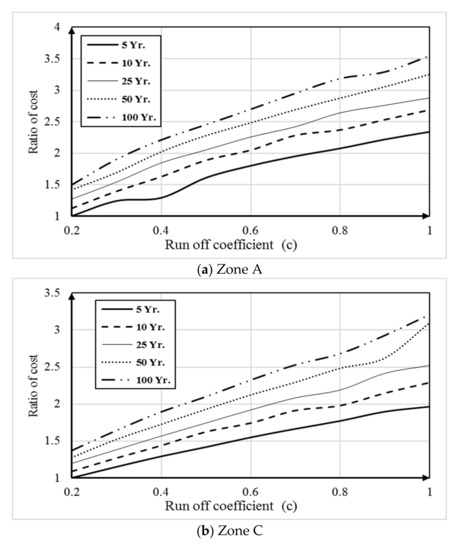
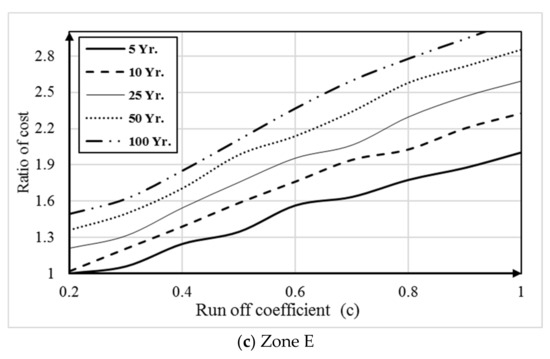
Figure 9.
Relationship between runoff coefficient (C) and storm network cost of zones A (a), C (b) and E (c).
As shown in Figure 9, increasing the runoff coefficient from 0.20 to 0.60 for return periods 5, 10, 25, 50 and 100 has increased the cost of the system by 1.75, 2, 2.25, 2.5 and 2.75 times that of the base case, respectively. However, increasing the runoff coefficient from 0.20 to 0.80 for return periods 5, 10, 25, 50 and 100 has increased the outfall discharge by 2.1, 2.4, 2.7, 2.8 and 3.25 times that of the base case, respectively. In the highest case, the runoff coefficient increased from 0.2 to one and the return period changed from five to 100. In this case, the cost will increase by 3.5 times that of the base case, as shown in Figure 9. This reveals that increasing the runoff coefficient due to urban growth has an apparent effect on the cost of a storm water drainage system.
The egression method was used to create an equation for the cost ratio based on the runoff coefficient and return period (Equation (5)). The confidence interval was equal to 94%. This equation was based on the available data for the three zones and can be applied to determine the cost ratio as follows:
where:
Cr = 0.625 + 2.071 × C + 0.0085 × T
- Cr = cost ratio
- C = runoff coefficient
- T = return period
4.3. Relationship between Runoff Coefficient and Average Velocity
This scenario presents the effect of changing the runoff coefficient (C) on the average velocity in the storm water drainage system. Increasing the runoff coefficient (C) increased the outfall discharge (Q), which increased the velocity in the system. StormCAD was used to assess the new runoff coefficients. The new outfall discharges and average velocities are calculated according to Manning’s equation. The relationship between the runoff coefficient (C) and the ratio of average velocity to the average velocity of the base case was calculated and is presented in Figure 10a–c for the three zones, A, C and E, respectively. The velocity (V) was calculated by StormCAD using Manning’s equation based on pipe slope and diameter. The velocity of flow at a return period of 5 years and a runoff coefficient equal to 0.20 is considered (Vo). The results show that increasing the runoff coefficient increased the average velocity and pipe diameter for the different return periods. The increase in velocity at the 100-year return period was between 1.5 and 1.8 times that of the base case, as shown in Figure 10.
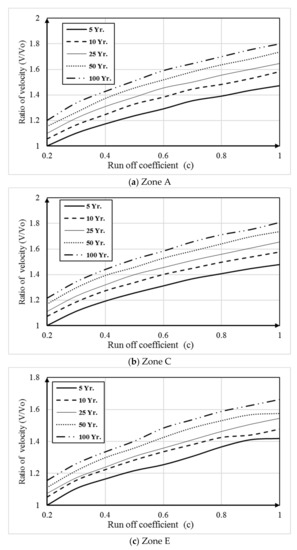
Figure 10.
Relationship between runoff coefficient (C) and average velocity for zones A (a), C (b) and E (c).
4.4. Relationship between Runoff Coefficient and Lag Time
This scenario is carried out to show the effect of changing the runoff coefficient (C) on the lag time for different return periods. Changes in urbanization have changed the runoff coefficient, which resulted in a change in the lag time. The relationship between the runoff coefficient (C) and the ratio of current lag time to the base case lag time was calculated and presented in Figure 11a–c for zones A, C and E, respectively. Increasing the runoff coefficient for different return periods decreased the lag time, which is important in a warning system. Increasing the runoff coefficient from 0.20 to 0.60 for return periods 5, 10, 25, 50 and 100 decreased the lag time by 0.85, 0.86, 0.87, 0.89 and 0.91 times that of the base case, respectively, as shown in Figure 9. The decrease in lag time at the 100-year return period was between 0.8 and 0.9 times that of the base case, as shown in Figure 11.
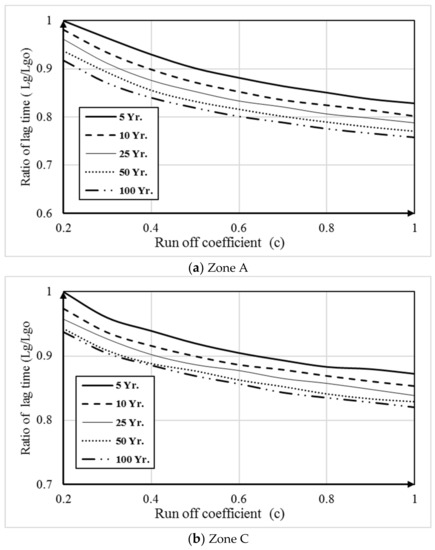
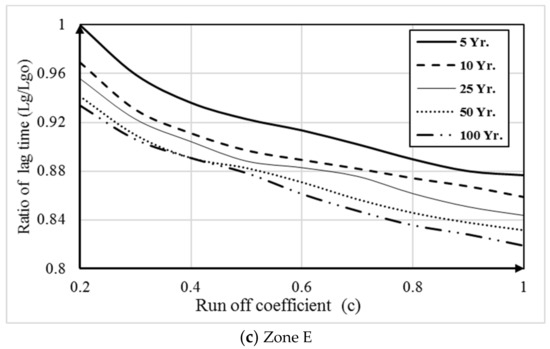
Figure 11.
Relationship between runoff coefficient (C) and lag time of zones A (a), C (b) and E (c).
Finally, comparisons between the studied parameters (outfall discharge, cost, velocity and lag time) for the different zones, A, C and E, are presented in Figure 12, Figure 13 and Figure 14 for the most common runoff coefficients, 0.50, 0.60 and 0.70, respectively. The comparisons revealed that, for all cases, the outfall discharge, velocity and total cost of the system have increased with the increasing runoff coefficient and lag time has decreased, which is important in the warning process. These results give the designer the opportunity to choose between the cost of the system and the safety of the studied areas, which mainly depend on the return periods and urbanization presented in the runoff coefficient. This can help the designer to obtain a primary estimation of the system before it is fully designed. This also can give the preliminary cost of the system.
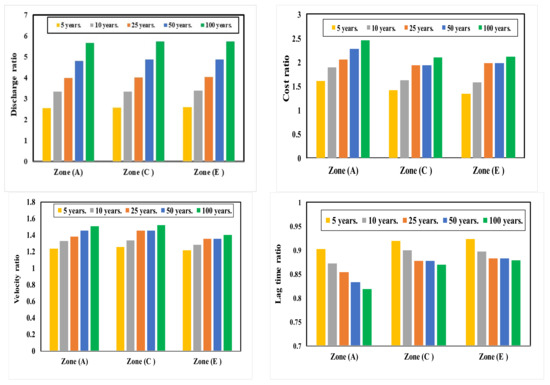
Figure 12.
Comparison between discharges, cost, velocity and lag time for zones A, C and E at runoff coefficient (C = 0.5).
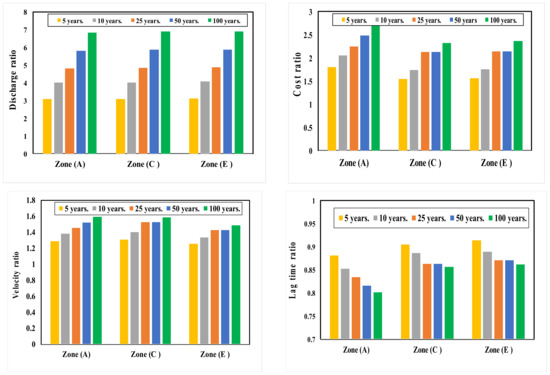
Figure 13.
Comparison between discharges, cost, velocity and lag time for zones A, C and E at runoff coefficient (C = 0.6).
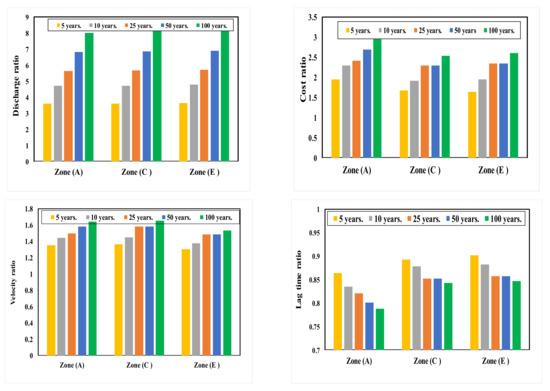
Figure 14.
Comparison between discharges, cost, velocity and lag time for zones A, C and E at runoff coefficient (C = 0.7).
According to the results and analysis, an equation was developed to calculate the maximum discharges of the regions that related most to the affecting variables in the study areas. This equation is a general equation that has been verified. Moreover, an empirical equation to calculate the cost ratio was developed to give an indication to decision makers in this regard. This equation is limited to the study area and will be updated in subsequent studies according to the availability of data.
5. Conclusions
Land use change due to urban growth is one of the main causes of floods in urban areas. Catchment area characteristics and rainfall intensity are the main factors affecting the design of storm water drainage systems. Urban growth leads to increases in the impermeability of the ground surface, which can lead to an increased possibility of flooding. The proper design of storm drainage systems in cities can help to minimize the effects of urbanization. The runoff coefficient is one of the main factors affecting the design of storm water drainage networks.
This study presents an assessment of the effect of changing the runoff coefficient due to urban growth on the design of storm water drainage systems.
- StormCAD software is used to assess the effect of different values of runoff coefficients on the discharge, velocity of the pipe network, lag time and cost of the pipe network;
- An empirical equation has been developed to predict the max discharge based on the data developed from the models. The discharge is a function of the return period, runoff coefficient, drainage density, longest path, rainfall intensity and catchment area;
- The developed equation is verified by application to estimate the discharge in a real case study in South Korea. Comparisons between the measured discharge and estimated discharge showed that the empirical equation is capable of predicting the maximum discharge for different catchments with high accuracy;
- Then, the validation of the models was carried out to assess the effect of the runoff coefficient on the design of a storm water drainage system in a case study in Dammam, KSA. The results revealed that increasing the runoff coefficient due to urban growth decreased the lag time and increased the outfall discharge, velocity and cost of construction of storm water drainage systems;
- The relationship between the cost and the runoff coefficient has been explored, which can help decision makers and designers to consider the effect of urban growth increasing the cost of large projects. The cost of the drainage system increased by two to three times in the case studies alongside the expected urban growth.
This study revealed that integrating land use change models and hydrological models could be a useful tool to evaluate the impact of urban growth. This is important for watershed management, water resource planning, and flood management for sustainable development. We recommend the use of some low-impact development systems (swales, bioretention, constructed wetland) to minimize the impact of urban growth.
Author Contributions
Conceptualization, M.Z.; methodology, I.F.; validation, I.F. and H.F.A.-E.; formal analysis, Z.V.; investigation, I.F.; resources, Z.V.; data curation, H.F.A.-E.; writing—original draft preparation, I.F.; writing—review and editing, H.F.A.-E. and M.Z.; visualization, I.F.; supervision, M.Z.; project administration, H.F.A.-E.; funding acquisition, Z.V. All authors have read and agreed to the published version of the manuscript.
Funding
This research received no external funding.
Acknowledgments
This work was supported by the projects of the Ministry of Education of the Slovak Republic, VEGA 1/0217/19: Research of Hybrid Blue and Green Infrastructure as Active Elements of a Sponge City, VEGA 1/0308/20: Mitigation of hydrological hazards—floods and droughts—by exploring extreme hydroclimatic phenomena in river basins and the project of the Slovak Research and Development Agency APVV-18-0360: Active hybrid infrastructure towards a sponge city.
Conflicts of Interest
The authors declare no conflict of interest.
References
- Zeleňáková, M.; Hluštík, P.; Abd-Elhamid, H.F.; Markovič, G.; Hudáková, G.; Tometz, L. Comprehensive study of the percolation of water from surface runoff with an emphasis on the retention capacity and intensity of precipitation. Water Sci. Technol. 2019, 79, 2407–2416. [Google Scholar] [CrossRef]
- Bentley. Storm sewer design and modeling. In Bentley StormCAD V8 XM User’s Guide; Bentley: Crewe, UK, 2006. [Google Scholar]
- Gould, S.E. Stormwater Management Model Development for Fairbanks; ASCE: Reston, VA, USA, 2016. [Google Scholar]
- Bentley. Bentley’s Stormwater Modeling Helps Paulus, Sokolowski, & Sartor, LLC Design Thunderbolt Raceway Motorsports Park’s Stormwater Systems; Bentley: Crewe, UK, 2009. [Google Scholar]
- Pazwash, H.A. Urban Stormwater Management; ASCE: Reston, VA, USA, 2011. [Google Scholar]
- Villarreal, E.A. Extension of Stormwater System at Östra Torn, Lund. In Global Solutions for Urban Drainage; ASCE: Reston, VA, USA, 2002. [Google Scholar]
- Jia, N.; Sitzenfrei, R.; Rauch, W.; Liang, S.; Liu, Y. Effects of Urban Forms on Separate Drainage Systems: A Virtual City Perspective. Water 2019, 11, 758. [Google Scholar] [CrossRef]
- Zhang, K.; Chui, T.F.M. Linking hydrological and bioecological benefits of green infrastructures across spatial scales-A literature review. Sci. Total Environ. 2019, 646, 1219–1231. [Google Scholar] [CrossRef] [PubMed]
- Huang, H.; Cheng, S.; Wen, J.; Lee, J. Effect of growing watershed imperviousness on hydrograph parameters and peak discharge. J. Hydrol. Process. 2008, 22, 2075–2085. [Google Scholar] [CrossRef]
- Du, J.; Qian, L.; Rui, H.; Zuo, T.; Zheng, D.; Xu, Y.C.; Xu, Y. Assessing the effects of urbanization on annual runoff and flood events using an integrated hydrological modeling system for Qinhuai River basin, China. J. Hydrol. 2012, 464–465, 127–139. [Google Scholar] [CrossRef]
- Hundecha, Y.; Bardossy, A. Modeling of the effect of land use changes on the runoff generation of a river basin through parameter regionalization of a watershed model. J. Hydrol. 2004, 292, 281–295. [Google Scholar] [CrossRef]
- Yanga, G.; Bowlinga, L.C.; Cherkauerb, K.A.; Pijanowskic, B.C. The impact of urban development on hydrologic regime from catchment to basin scales. Landsc. Urban Plan. 2011, 103, 237–247. [Google Scholar] [CrossRef]
- Kumar, P.S.; Santhi, T.; Srivatsav, P.M.; Reddy, D.V.; Prasad, M.A.; Praveen, T.V. Storm Water Drainage Design (Case Study Vijayawada). Int. J. Earth Sci. Eng. 2015, 8, 507–511. [Google Scholar]
- Kumar, K.P.; Barik, D.K.; Manideep, C. A Comparative Study of Storm Water Drainage Methods for Urban Storm Water Management. Indian J. Sci. Technol. 2015, 8, 1–9. [Google Scholar]
- Li, C.; Liu, M.; Hu, Y.; Shi, T.; Qu, X.; Walter, M.T. Effects of urbanization on direct runoff characteristics in urban functional zones. Sci. Total Environ. 2018, 643, 301–311. [Google Scholar] [CrossRef]
- Da Silva, C.V.F.; Schardong, A.; Garcia, J.I.B.; Oliveira, C.D.P.M. Climate Change Impacts and Flood Control Measures for Highly Developed Urban Watersheds. Water 2018, 10, 829. [Google Scholar] [CrossRef]
- Semadeni-Davies, A.; Hernebring, C.; Svensson, G.; Gustafsson, L.G. The impacts of climate change and urbanization on drainage in Helsingborg, Sweden: Suburban Stormwater. J. Hydrol. 2008, 350, 114–125. [Google Scholar] [CrossRef]
- Jacobs, J.H.; Srinivasan, R. Effects of curve number modification on runoff estimation using WSR-88D rainfall data in Texas watersheds. J. Soil Water Conserv. 2005, 60, 274–279. [Google Scholar]
- Zhou, Q.; Leng, G.; Su, J.; Ren, Y. Comparison of urbanization and climate change impacts on urban flood volumes: Importance of urban planning and drainage adaptation. Sci. Total Environ. 2018, 658, 24–33. [Google Scholar] [CrossRef] [PubMed]
- Bach, P.M.; Deletic, A.; Urich, C.; McCarthy, D.T. Modelling characteristics of the urban form to support water systems planning. Environ. Model. Softw. 2018, 104, 249–269. [Google Scholar] [CrossRef]
- Mikovits, C.; Rauch, W.; Kleidorfer, M. Importance of scenario analysis in urban development for urban water infrastructure planning and management. Comput. Environ. Syst. 2018, 68, 9–16. [Google Scholar] [CrossRef]
- Youssef, A.; Sefry, S.; Pradhan, B.; Abu Alfadail, E. Analysis on causes of flash flood in Jeddah city (Kingdom of Saudi Arabia) of 2009 and 2011 using multi-sensor remote sensing data and GIS. Geomat. Nat. Hazards Risk 2016, 7, 1018–1042. [Google Scholar] [CrossRef]
- Haq, M.; Akhtar, M.; Muhammad, S.; Paras, S.; Rahmatullah, J. Techniques of remote sensing and GIS for flood monitoring and damage assessment: A case study of Sindh province, Pakistan. Egypt. J. Remote Sens. Space Sci. 2012, 15, 135–141. [Google Scholar] [CrossRef]
- Pradhan, B. Flood susceptible mapping and risk area estimation using logistic regression, GIS and remote sensing. J. Spat. Hydrol. 2010, 9, 1–18. [Google Scholar]
- Dawod, G.; Mirza, M.; Al-Ghamdi, K. Assessment of several flood estimation methodologies in Makkah metropolitan area, Saudi Arabia. Arab. J. Geosci. 2011. [Google Scholar] [CrossRef]
- Abosuliman, S.; Kumar, A.; Alam, F. Flood Disaster Planning and Management in Jeddah, Saudi Arabia—A Survey. In Proceedings of the International Conference on Industrial Engineering and Operations Management, Bali, Indonesia, 7–9 January 2014. [Google Scholar]
- Youssef, A.; Pradhan, B.; Sefry, S. Remote sensing-based studies coupled with field data reveal urgent solutions to avert the risk of flash floods in the Wadi Qus (east of Jeddah) Kingdom of Saudi Arabia. Nat. Hazards 2014, 75, 1465–1488. [Google Scholar] [CrossRef]
- Li, F.; Duan, H.; Yan, H.; Tao, T. Multi-Objective Optimal Design of Detention Tanks in the Urban Storm Water Drainage System: Framework Development and Case Study. Water Resour. Manag. 2015, 29, 2125–2137. [Google Scholar] [CrossRef]
- Su, H.T.; Cheung, S.; Lo, E. Multi-objective optimal design for flood risk management with resilience objectives. Stoch. Environ. Res. Risk Assess. 2018. [Google Scholar] [CrossRef]
- Duan, H.; Li, F.; Tao, T. Multi-objective Optimal Design of Detention Tanks in the Urban Storm Water Drainage System: Uncertainty and Sensitivity Analysis. Water Resour. Manag. 2016, 30, 2213–2226. [Google Scholar] [CrossRef]
- Li, F.; Yan, X.; Duan, H. Sustainable Design of Urban Stormwater Drainage Systems by Implementing Detention Tank and LID Measures for Flooding Risk Control and Water Quality Management. Water Resour. Manag. 2019, 33, 3271–3288. [Google Scholar] [CrossRef]
- Mohammadiun, S.; Yazdi, J.; Neyshabouri, S.; Sadiq, R. Development of a stochastic framework to design/rehabilitate urban stormwater drainage systems based on a resilient approach. Urban Water J. 2018. [Google Scholar] [CrossRef]
- Wagh, M.R.; Salunkhe, S.R.; Sawant, S.S.; Rathod, S.R.; Salunke, P.J. Applications of Softwares in Environmental Engineering. Int. J. Adv. Res. Dev. 2018, 3, 187–191. [Google Scholar]
- Texas Department of Transportation. Hydraulic Design Manual; Texas Department of Transportation: Austin, TX, USA, 2004. [Google Scholar]
- Chow, V.T.; Maidment, D.R.; Mays, L.W. Applied Hydrology; McGraw-Hill Book Company: New York, NY, USA, 1988. [Google Scholar]
- Bell, C. Generalized rainfall duration frequency relationships. J. Hydraul. Div. ASCE 1969, 95, 311–327. [Google Scholar]
- Le Minh, N.; Yasuto, T.; Kaoru, T. Establishment of Intensity-Duration-Frequency Curves for Precipitation in the Monsoon Area of Vietnam; No. 49 B; Annuals Disaster Prevention Research Institute, Kyoto University: Kyoto, Japan, 2006. [Google Scholar]
- Saudi Aramco, Ownership Development Program Package (1) Infrastructure, Design Basis and Calculations; Technical Report; Aramco company: Dharam, Saudi Arabia, 2015.
- Lee, J.; Chung, G.; Park, H.; Park, I. Evaluation of the Structure of Urban Storm Water Pipe Network Using Drainage Density. Water 2018, 10, 1444. [Google Scholar] [CrossRef]
© 2020 by the authors. Licensee MDPI, Basel, Switzerland. This article is an open access article distributed under the terms and conditions of the Creative Commons Attribution (CC BY) license (http://creativecommons.org/licenses/by/4.0/).